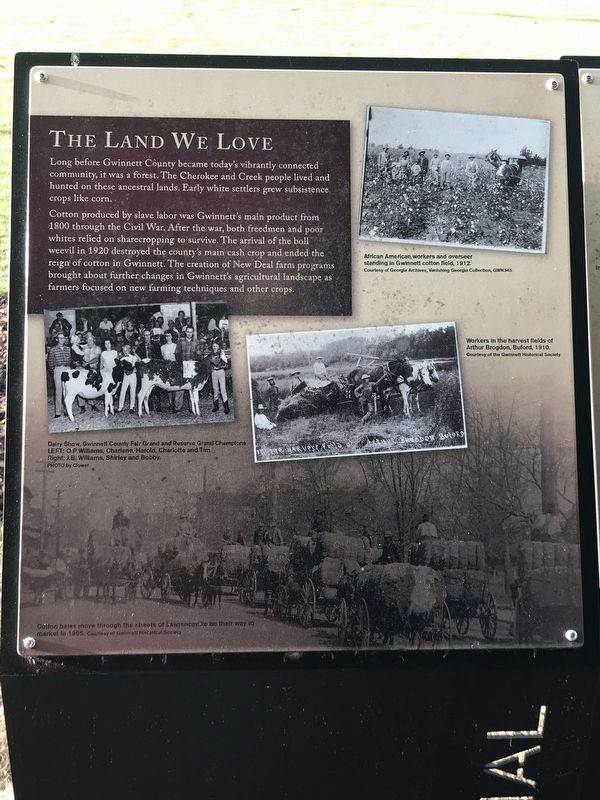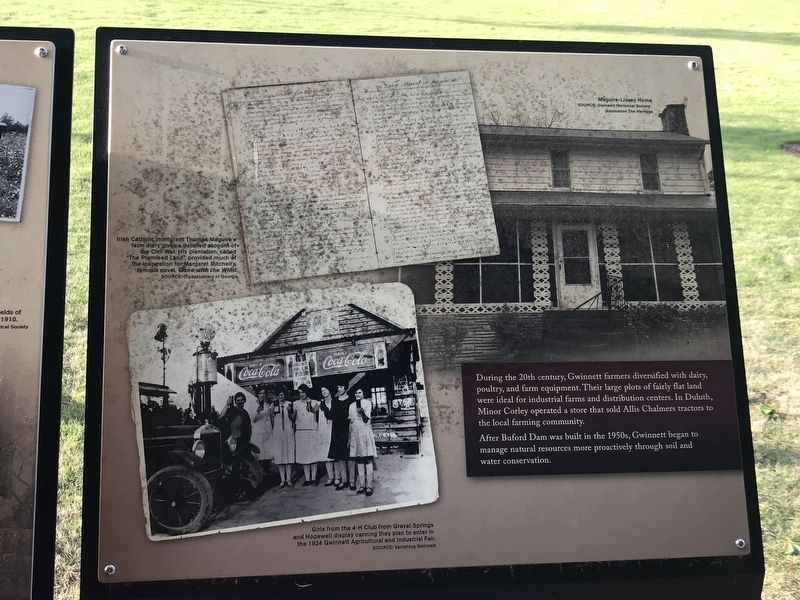Lawrenceville in Gwinnett County, Georgia — The American South (South Atlantic)
The Land We Love
Cotton produced by slave labor was Gwinnett's main product from 1800 through the Civil War. After the war, both freedmen and poor whites relied on sharecropping to survive. The arrival of the boll weevil in 1920 destroyed the county's main cash crop and ended the reign of cotton in Gwinnett. The creation of New Deal farm programs brought about further changes in Gwinnett's agricultural landscape as farmers focused on new farming techniques and other crops.
[Captions (clockwise from top right)]
• African American workers and overseer standing in Gwinnett cotton field, 1912. Courtesy of Georgia Archives, Vanishing Georgia Collection, GWN 345
• Workers in the harvest fields of Arthur Brogdon, Buford, 1910. Courtesy of the Gwinnett Historical Society
• Dairy Show, Gwinnett County Fair Ground and Reserve Grand Champions Left: O.P. Williams, Charlene, Harold, Charlotte and Tim Right: J.B. Williams, Shirley and Bobby. Photo by Clower
• (Background) Cotton bales move through the streets of Lawrenceville on their way to market in 1905. Courtesy of the Gwinnett Historical Society
[Right panel]
During the 20th century Gwinnett farmers diversified with dairy, poultry, and farm equipment. Their large plots of fairly flat land were ideal for industrial farms and distribution centers. In Duluth, Minor Corley operated a store that sold Allis Chalmers tractors to the local farming community.
After Buford Dam was built in the 1950s, Gwinnett began to manage natural resources more proactively through soil and water conservation.
[Captions]
• (Background) Maguire-Livsey House. Source. Gwinnett Historical Society publication The Heritage
Society • (Top) Irish Catholic immigrant Thomas Maguire's farm diary gives a detailed account of the Civil War. His plantation, called "The Promised Land," provided musch of the inspiration for Margaret Mitchell's famous novel, Gone with the Wind. Source: Digital Library of Georgia
• (Bottom) Girls from the 4-H Club from Gravel Springs and Hopewell display canning they plan to enter in the 1924 Gwinnett Agricultural and Industrial Fair. Source: Vanishing Gwinnett
Erected 2018 by Gwinnett County.
Topics. This historical marker is listed in these topic lists: Agriculture • Industry & Commerce. A significant historical year for this entry is 1800.
Location. 33° 57.271′ N, 83° 59.316′ W. Marker is in Lawrenceville, Georgia, in Gwinnett County. Marker can be reached from South Clayton Street (Georgia Route 20) south of Luckie Street, on the right when traveling south. Marker is in the Gwinnett County Bicentennial Plaza. Touch for map. Marker is at or near this postal address: 42 S Clayton St, Lawrenceville GA 30046, United States of America. Touch for directions.
Other nearby markers. At least 8 other markers are within walking distance of this marker. The History of Peachtree (a few steps from this marker); Unsurpassed Quality of Life (a few steps from this marker); African American Roles in the Community (a few steps from this marker); Gwinnett: A Great Investment (within shouting distance of this marker); Gwinnett County Bicentennial Time Capsule (within shouting distance of this marker); Lake Lanier is Born (within shouting distance of this marker); From Near and Far (within shouting distance of this marker); The Land Lottery of 1820 (within shouting distance of this marker). Touch for a list and map of all markers in Lawrenceville.
Credits. This page was last revised on May 12, 2022. It was originally submitted on May 12, 2022, by Duane and Tracy Marsteller of Murfreesboro, Tennessee. This page has been viewed 164 times since then and 41 times this year. Photos: 1, 2. submitted on May 12, 2022, by Duane and Tracy Marsteller of Murfreesboro, Tennessee.

